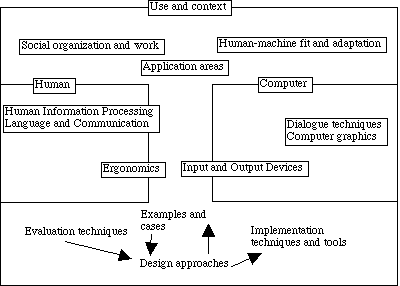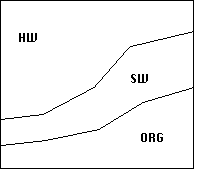2. Basic concepts (Preece Chapter 1)
Human-Computer Interaction - Interface
This course deals with the interaction between a user and information systems
- or more generally tools for some purpose
We deal with human and computer qualities. What are the basic properties
of human beings that make it easy or difficult to deal with computers.
And what are the tools and techniques that are used in building software
or information systems
Furthermore, we take a look at design tools that can be used in creating
systems that are easy to use in performing specific tasks.
In the early days of computing the computers were separated from the
work of people who used the output of information systems of produced data
for the information systems. The interface for the system was merely the
forms for collecting data and the design of the printout forms.
Modern information systems and software tools are an essential part
of most work settings. The interface is also a tool to be used by the workers.
Terms
-
User Interface , Man-Machine Interface(MMI)
-
Those aspects of the system that the user comes in contact with (Moran,
1981) - an input language for the user, an output language for the system
and a protocoll for interaction
-
Human-Computer Interaction (HCI)
-
A set of processes, dialogues, and actions through which a human user employs
and interacts with a computer (Baecker and Buxton, 1987)
-
Human-Computer Interaction (HCI)
-
a dicipline concerned with the design, evaluation and implementation of
interactive computing systems for human use and with the study of major
phenomena surrounding them (ACM SIGCHI, 1992)
Two views
-
System and interface as separate units (interface as "surface")
-
Systems suitable for some task (design task)
The measure of good design
-
Technologically advanced affordable system
-
Satisfied - motivated user
-
Makes possible good job design or is part of a good task
-
Promotes organizational goals
In case of poor design the problem might be in the interface or in the
system functionality
Think of some household device (TV, Video, Doorbell, Coffee Machine). Try
to identify their interface and functionality and think what could be wrong
with them.
Two basic concepts: visibility and affordance
Donald Norman uses concepts visibility and affordance in describing general
goals in user centered design.
-
visibility
-
All necessary controls should be visible for the user whenever he/she is
supposed to be able to use them
-
affordance
-
Technical term that refers to the properties of objects - what sorts of
operations and manipulations can be done to a particular object (Norman).
The appearance of the controls shouls suggest the way they are to be used
(pulled, pushed, slided, checked, dragged, dropped,....) and what will
happen if you use them.
Exercise: What is the role of visibility and affordance in the following
systems and why:
-
mobile phone
-
bank automate - teller machine
-
companys payroll system
-
librarys search system
-
eMarket
The User
Who is the user:
-
Casual user: Knows only the basic techniques at the interface. Must be
able to use the system right the first time.
-
Regular user: Uses the system regularly, but not an expert
-
Professional user: Uses the system as a part of the job works with the
system.
-
Developing user: Uses the system to construct the working environment.
The system should be developed and evaluated in the user context. Some
systems have several different user groups. The user can be in different
category using different systems.
Which user class?
-
Mobile phone user
-
Vending machine
-
eShopper
-
CAD-designer
-
Cashier
Context of HCI
 The dicipline
of HCI
The dicipline
of HCI
The research in HCI has originated in technical tools and programming
deatils. At the moment a more wide perspective is taken in the HCI research.
Main topics are groupwork, effects on work, individuals, integration techniques
and tools.
Productivity and HCI
Productivity can be increased in two basic ways: automation and
job
enrichment : Discuss how automation and job enrichment (though opposite
issues) can result in better productivity. About ther same discussion is
valid when considering whether automationin creases or decreases unemplyment.
| Resource deployment |
|
|
Tangible benefits |
|
Cost Reduction |
Staff savings, cost savings |
|
|
Improved productivity |
More work done more messages transmitted |
|
|
Improved support |
Improved information decission support |
|
|
Organizational enhancement |
New forms of integration new forms of business |
|
| Work enhancing |
|
|
Intangible benefits |
IT benefits in an office (Eason)
Costs of new systems
The costs of implementing new systems has changed from hardware to software
and furthermore to organizational costs (changes in working conditions
- changes in organization - new ways of working et c.)
 Costs of implementing
new systems (Bjorn-Andersen)
Costs of implementing
new systems (Bjorn-Andersen)
Impacts of IT on jobs
Technical systems can be use as controls or as tools. The use of IT in
these roles can cause the following effects
| Objective |
|
| Technical system as control |
Technical system as tool |
| JOB CHANGES |
|
| Deskilled |
Enriched |
| Paced |
Unpaced |
| Structured |
Unstructured |
| Monitored |
Not monitored |
| Repetitive |
Varied |
| Isolated |
Social contact |
| HUMAN RESPONSES |
|
| Dissatisfaction |
Satisfaction |
| Machine stress |
No machine stress |
| ORGANIZATIONAL EFFECT |
|
| Higher productivity |
Similar productivity |
| Control mechanisms |
Quality and initiative |
| Inflexibility |
Flexibility |
The impact of IT on jobs
mj@uwasa.fi 27.2.2001
 The dicipline
of HCI
The dicipline
of HCI
 Costs of implementing
new systems (Bjorn-Andersen)
Costs of implementing
new systems (Bjorn-Andersen)